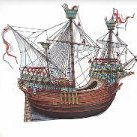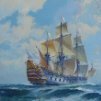Supplies of the Ship Modeler's Handbook are running out. Get your copy NOW before they are gone! Click on photo to order.
×
-
Posts
8,149 -
Joined
-
Last visited
Reputation Activity
-
 allanyed reacted to Chuck in HMS Portland 1770 by scrubbyj427 - 1:48 - 4th rate 50-gun ship
allanyed reacted to Chuck in HMS Portland 1770 by scrubbyj427 - 1:48 - 4th rate 50-gun ship
Looking good….but thats not a fair fight…
the Winnie is hopelessly outgunned!!!
-
 allanyed reacted to glbarlow in HMS Portland 1770 by scrubbyj427 - 1:48 - 4th rate 50-gun ship
allanyed reacted to glbarlow in HMS Portland 1770 by scrubbyj427 - 1:48 - 4th rate 50-gun ship
I’d love to build this but all the fairing and planking. Actually that I could do, finding a place to display it might require marriage counseling.
-
 allanyed reacted to Morgan in General Ships Cleaning Equipment, HMS Victory, 1805
allanyed reacted to Morgan in General Ships Cleaning Equipment, HMS Victory, 1805
To add to the conversation, First Rates like Victory had 850 crew, it was necessary to keep them busy and not allow them to stew over their confinement. Cleaning ship was one means of keeping otherwise idle hands busy and from fermenting trouble, so they did lots of it.
There are no gun deck storage areas for cleaning equipment, this would have gotten in the way of having a clear area from stem to stern when cleared for action, so these items would have been stored in the hold.
Gary
-
 allanyed reacted to Bob Cleek in General Ships Cleaning Equipment, HMS Victory, 1805
allanyed reacted to Bob Cleek in General Ships Cleaning Equipment, HMS Victory, 1805
There are certainly far more knowledgeable folks in this forum that I am on the particular practices of this period, but from my own experience, some of these details don't appear correct. I doubt that decks would be rinsed with clean (fresh - not salt) water and particularly not at sea. Fresh water is a precious commodity and is conserved for cooking and drinking and, to a very limited extent, bathing and rinsing salt out of clothing. (where it will attract moisture, keeping clothing continually damp. Decks are swabbed and rinsed with salt water because fresh water leaking below causes fungal decay while salt water does not and, in fact, to a certain extent prevents it. Additionally, the salt in the decks attracts moisture and tends to keep the deck planking swelled and bleached, as well.
Decks were holystoned not to remove salt from the deck, but to remove tar (pitch) from the deck which otherwise would get tracked all over the vessel. As Allan mentioned, in the days when the Admiralty placed a high-value on its ships being highly maintained, Admiral St. Vincent even went so far as to order every ship to holystone her decks "every evening as well as morning in the summer months." The reason for holystoning twice in the summer months was because the heat in the summertime increased the amount of tar that dripped from aloft and tracked all over the ship. Pine "tar" (pitch, actually) was applied liberally to the rigging for its preservation and heated and poured as "stopping" on top of the oakum caulking material hammered into deck planking seams. In the summer sun, the dark brown, nearly black actually, pitch would liquify and drip down from the top hamper where it thickly coated everything and it would soften in the deck seams and get spread all over the deck. Holystoning decks would cause the sand to pick up the pitch and in removing the sand, a fair amount of the pitch would be removed as well. In the early 1800's, a couple of significant developments caused an evolution of practices in the Admiralty. One was that England broke free from her from dependence on the Scandinavian boreal forests as a source of naval stores such as shipbuilding timber and pine tar, competition for which exerted a great influence over European politics. England's American colonies exceeded the entire European supply of naval stores freed England from dependence on what was called "Stockholm tar" and the citizens of then heavily pine forested colony of North Carolina went into the pine tar business thereby earned their nickname, "tar heels." In 1840, an enterprising British inventor, Alfred Jeffery, discovered that bitumen or "coal tar" which was beginning to replace "pine tar" for some purposes, when melted and mixed with another relatively new material which also became commonly available around that time, latex or natural "rubber," produced a greatly improved deck seam stopping. The major advantages of Jeffrey's "marine glue," as he called it, was that it could be melted and poured into a seam and when it cooled, it would still stick to the wood, but was "rubbery" and would stretch when the seams opened and closed as the wood moved. Mr. Jeffery took his product to the Admiralty which immediately specified it for every deck seam in the British navy from then on. Jeffery's Marine Glue is still made in England today. (Check out the post at https://forum.woodenboat.com/forum/tools-materials-techniques-products/252396-for an old Jeffrey and Company's instruction manual PDF. It explains in detail all about deck seams from about 1840 on.)
I expect that most of the holystoning detritus and sweepings would be flushed and/or swept overboard through the deck scuppers.
While a rope would obviously serve in a pinch, I'd expect that a knotted rope would serve no purpose because the knots would foul in the limber holes more often than not and require accessing the entire length of the bilges to locate the hang-up and free it, thus defeating the purpose of the entire exercise. More over, the rope would rot rather quickly and result in a rather nasty job of removal, since it wasn't uncommon for seamen to use the bilge for a latrine when convenient. (A trip to the heads was no fun in foul weather in the Age of Sail!) This question was raised recently in another post and I don't think it was answered, but while I have always heard of and dealt with "limber chains," I've never heard nor encountered a "limber rope." Modernly, limber chains are made of non-ferrous metal, usually copper or brass to avoid corrosion. I don't know if this was the case in days of old, but there's no reason they couldn't have been.
-
 allanyed reacted to Beckmann in Whaleboat by Beckmann - FINISHED - RESTORATION - bone model
allanyed reacted to Beckmann in Whaleboat by Beckmann - FINISHED - RESTORATION - bone model
After being busy with other projects, I now want to continue with the restoration of the bone model I already showed you back in 2021.
I found a couple of similar models in auctions around the world, several of them made by the same builder Albertino Sousa Luz.
In fact, almost all of the models seem to be signed by A.S.Luz.
So it is propably a retired (and very talented) whaler who made them rather then a local tradition.
I dismantled my model, becaus it was a dirty mess and started to clean it first with a dry brush and then with a wet ear stick.
I am happy to say, that no parts are missing. All of the long oars, the steering oar, the paddles, the rudder, the rowing oarlocks and the hunting tools are still there. Some of them were fixed to the model with rope. I removed these ropes, because they were very dirty and partly unraveled, I will replace them.
Here you can see the harpune rope-drum.
I also cleaned the sails.
The mast-rings are made from plastic and don't look very nice. I will propably replace them by rings made from bone.
Matthias
-
 allanyed got a reaction from druxey in 19th Century Fisherman by Ferrus Manus - FINISHED - 1/96 - little project to keep me sane
allanyed got a reaction from druxey in 19th Century Fisherman by Ferrus Manus - FINISHED - 1/96 - little project to keep me sane
FM
They do not have logs as far as I know, but rather really fine books. Examples of where to buy them are below, but you can find more with a quick search.
Ships in Miniature by Lloyd McCaffery, Ship Models in Miniature by Donald McNarry, Building a Miniature Navy Board Model by Philip Reed . Used copies can be found on the net.
https://www.amazon.com/SHIPS-MINIATURE-Classic-Manual-Modelmakers/dp/0851774857
https://www.thriftbooks.com/w/ship-models-in-miniature_donald-mcnarry/809946/item/11675885/?utm_source=google&utm_medium=cpc&utm_campaign=pmax_high_vol_frontlist_under_%2410&utm_adgroup=&utm_term=&utm_content=&gclid=CjwKCAjwgsqoBhBNEiwAwe5w05wB-HnnCRai6e9CtxTveUJykqoZNyCqe5-ln8wsDXSZI03IEQOltxoC0xIQAvD_BwE#idiq=11675885&edition=3619299
https://www.abebooks.com/9781848320178/Building-Miniature-Navy-Board-Ship-1848320175/plp
-
 allanyed got a reaction from CiscoH in US Brig Syren by bobandlucy - Model Shipways - 1:64
allanyed got a reaction from CiscoH in US Brig Syren by bobandlucy - Model Shipways - 1:64
Bob/Lucy
Have you looked at any planking expansion drawings? The strakes widen at the stern towards the keel and in the following cases they narrow closer to the wales. https://www.rmg.co.uk/collections/objects/rmgc-object-83709 and https://www.rmg.co.uk/collections/objects/rmgc-object-83495 show two examples. They show outboard planking as well as inboard planking.
Allan
-
 allanyed got a reaction from Ferrus Manus in 19th Century Fisherman by Ferrus Manus - FINISHED - 1/96 - little project to keep me sane
allanyed got a reaction from Ferrus Manus in 19th Century Fisherman by Ferrus Manus - FINISHED - 1/96 - little project to keep me sane
Hi FM
At the scale you are working, very nice work. Just curious as your topic is titled fishing boat, but with seven thwarts, it strongly resembles a ship's boat circa 17th-18th centuries. No matter, very neatly done!
Thanks for sharing!
Allan
-
 allanyed got a reaction from mtaylor in General Ships Cleaning Equipment, HMS Victory, 1805
allanyed got a reaction from mtaylor in General Ships Cleaning Equipment, HMS Victory, 1805
I have no ideas where the gear was stored when not in use, but found the following very interesting. From Brian Lavery:
Holystoning was a routine activity on Royal Navy vessels until the early 1800s. The practice reached its height in 1796 when Admiral St Vincent recommended to his captains that the decks of all ships in the fleet be holystoned "every evening as well as morning during the summer months." For a ship of the line, the practice could take up to four hours.
St Vincent's successor, Admiral Keith, rescinded the order in 1801, finding that "the custom of washing the decks of ships of war in all climates in every temperature of the air, and on stated days let the weather be what it may" was so onerous as to be damaging the health and lives of the crews. The practice was subsequently limited to once every seven to fourteen days, interspersed with sweeping.
The after hold was the common area for ready to use things other than food and spirits so MAYBE that would be appropriate.
I too would be very interested in finding out where these things would be stored based on contemporary sources.
Allan
-
 allanyed got a reaction from HAIIAPHNK in General Ships Cleaning Equipment, HMS Victory, 1805
allanyed got a reaction from HAIIAPHNK in General Ships Cleaning Equipment, HMS Victory, 1805
I have no ideas where the gear was stored when not in use, but found the following very interesting. From Brian Lavery:
Holystoning was a routine activity on Royal Navy vessels until the early 1800s. The practice reached its height in 1796 when Admiral St Vincent recommended to his captains that the decks of all ships in the fleet be holystoned "every evening as well as morning during the summer months." For a ship of the line, the practice could take up to four hours.
St Vincent's successor, Admiral Keith, rescinded the order in 1801, finding that "the custom of washing the decks of ships of war in all climates in every temperature of the air, and on stated days let the weather be what it may" was so onerous as to be damaging the health and lives of the crews. The practice was subsequently limited to once every seven to fourteen days, interspersed with sweeping.
The after hold was the common area for ready to use things other than food and spirits so MAYBE that would be appropriate.
I too would be very interested in finding out where these things would be stored based on contemporary sources.
Allan
-
 allanyed reacted to tmj in General Ships Cleaning Equipment, HMS Victory, 1805
allanyed reacted to tmj in General Ships Cleaning Equipment, HMS Victory, 1805
One thing that I have never seen depicted, in sectional models, are the general 'every day' items used to keep the ship's decks clean, etc. There's no such thing as a ship without proper 'janitorial' tools!
Other than brooms, mops and buckets... what other janitorial 'devices' would have been found on the decks of HMS Victory in 1805? Also, weren't certain 'stones' used to occasionally 'grind' the surface of the decks to a smooth, splinter free surface? Where would this kind of gear/equipment typically be stowed upon the different decks of a ship like this?
-
 allanyed got a reaction from Jaager in 19th Century Fisherman by Ferrus Manus - FINISHED - 1/96 - little project to keep me sane
allanyed got a reaction from Jaager in 19th Century Fisherman by Ferrus Manus - FINISHED - 1/96 - little project to keep me sane
FM
They do not have logs as far as I know, but rather really fine books. Examples of where to buy them are below, but you can find more with a quick search.
Ships in Miniature by Lloyd McCaffery, Ship Models in Miniature by Donald McNarry, Building a Miniature Navy Board Model by Philip Reed . Used copies can be found on the net.
https://www.amazon.com/SHIPS-MINIATURE-Classic-Manual-Modelmakers/dp/0851774857
https://www.thriftbooks.com/w/ship-models-in-miniature_donald-mcnarry/809946/item/11675885/?utm_source=google&utm_medium=cpc&utm_campaign=pmax_high_vol_frontlist_under_%2410&utm_adgroup=&utm_term=&utm_content=&gclid=CjwKCAjwgsqoBhBNEiwAwe5w05wB-HnnCRai6e9CtxTveUJykqoZNyCqe5-ln8wsDXSZI03IEQOltxoC0xIQAvD_BwE#idiq=11675885&edition=3619299
https://www.abebooks.com/9781848320178/Building-Miniature-Navy-Board-Ship-1848320175/plp
-
 allanyed got a reaction from mtaylor in 18-Pounder Pivot Gun
allanyed got a reaction from mtaylor in 18-Pounder Pivot Gun
https://www.rmg.co.uk/collections/objects/rmgc-object-85013 for a contemporary drawing from the Dolphin 1836 and Rapid 1840
Allan
-
 allanyed reacted to bruce d in 19th Century Fisherman by Ferrus Manus - FINISHED - 1/96 - little project to keep me sane
allanyed reacted to bruce d in 19th Century Fisherman by Ferrus Manus - FINISHED - 1/96 - little project to keep me sane
FM, good advice (as usual) from Allan, and another book by Philip Reed is close to your stated needs:
PERIOD SHIP MODELMAKING An Illustrated Masterclass
It's on Ebay, AbeBooks and other places as well. In iit he walks us through building Prince de Neufchatel in 1/192 scale.
McNarry and his wife were superb modelmakers and won quite a few pots at early Model Engineer Exhibitions in London.
HTH,
Bruce
-
 allanyed reacted to Morgan in 1:98 Wooden Stanchions for HMS Victory
allanyed reacted to Morgan in 1:98 Wooden Stanchions for HMS Victory
There was a specific screw jack supplied that fractionally lifted the beam and allowed the wooden stanchion to be removed.
Victory does have some brass stanchions as well which are hinged and swung up out of the way, from memory these are in the vicinity of one of the capstans, I believe they are a later addition and can also be found on the Trincomalee.
Gary
-
 allanyed reacted to highlanderburial in 18-Pounder Pivot Gun
allanyed reacted to highlanderburial in 18-Pounder Pivot Gun
That drawing is artwork onto itself. A very cool reference. Thanks for posting!
-
 allanyed got a reaction from thibaultron in 18-Pounder Pivot Gun
allanyed got a reaction from thibaultron in 18-Pounder Pivot Gun
https://www.rmg.co.uk/collections/objects/rmgc-object-85013 for a contemporary drawing from the Dolphin 1836 and Rapid 1840
Allan
-

-
 allanyed reacted to Mike Collier in The Skipjack by Dennis Powell - using Wye River Models plans and materials
allanyed reacted to Mike Collier in The Skipjack by Dennis Powell - using Wye River Models plans and materials
Is the Skipjack book the instruction manual? I’ll be following this build. I really like building Wye River Models!
-
 allanyed reacted to thibaultron in The Skipjack by Dennis Powell - using Wye River Models plans and materials
allanyed reacted to thibaultron in The Skipjack by Dennis Powell - using Wye River Models plans and materials
"The Skipjack" book is a manual for scratch building a generic Skipjack, and quite good. The Willie Bennett book is the instruction manual for the Model Expo kit.
-
 allanyed got a reaction from druxey in 19th Century Fisherman by Ferrus Manus - FINISHED - 1/96 - little project to keep me sane
allanyed got a reaction from druxey in 19th Century Fisherman by Ferrus Manus - FINISHED - 1/96 - little project to keep me sane
Ferrus manus.... (that looks like a flesh hand in the photo😀)
Have you looked at the methods used in the books by the masters of the tiny scale, McCaffery, McNarry and Reed? They cover how to make rigging items such as blocks, what materials to use for lines, and more. Your scale is larger by comparison, but there may be some great tips for you.
Allan
-
 allanyed got a reaction from DaveBaxt in Frigate Diana by RossR - FINISHED - OcCre - 1:85
allanyed got a reaction from DaveBaxt in Frigate Diana by RossR - FINISHED - OcCre - 1:85
The pintles and gudgeons are fun little projects to practice soldering techniques, congrats for giving it a go! If not too late, or for the future, the below shows the approximate sizes of the various parts and number of bolts on a typical 32 gun British ship in the 1790s. I suspect the Spanish ships would be similar. For your scale of 1:85, the straps would be 0.047" (1.2mm) wide, the pin would be about 0.035" (0.9mm) and the bolt heads would be about 0.018 (0.45mm) Note the lengths of the straps and the number of bolts as well. I show the dimensions of the lower one, but you can size the rest using the scale to get an idea of their respective lengths. For the lower ones at your scale, they are about 0.53" (13.5mm) and 0.81" (20.6mm) The materials used were typically copper or iron. If you use copper you can blacken them once installed with liver of sulfur to represent iron or leave them clean to show as copper. Again, it may be different for Spanish ships, but this information should be close.
Allan
-
 allanyed got a reaction from Bill Morrison in HMS Diana 1794 by newbee - Caldercraft - 1/64
allanyed got a reaction from Bill Morrison in HMS Diana 1794 by newbee - Caldercraft - 1/64
To me, the most remarkable thing is that those craftsmen 250 years ago had no electrical tools at all. The patience and skill they had to create these works of art is incredible.
Allan
-
 allanyed got a reaction from bruce d in 19th Century Fisherman by Ferrus Manus - FINISHED - 1/96 - little project to keep me sane
allanyed got a reaction from bruce d in 19th Century Fisherman by Ferrus Manus - FINISHED - 1/96 - little project to keep me sane
Ferrus manus.... (that looks like a flesh hand in the photo😀)
Have you looked at the methods used in the books by the masters of the tiny scale, McCaffery, McNarry and Reed? They cover how to make rigging items such as blocks, what materials to use for lines, and more. Your scale is larger by comparison, but there may be some great tips for you.
Allan
-












